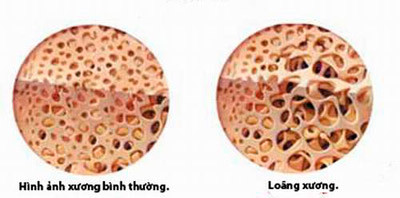Prevention of postmenopausal osteoporosis
The disease is common in the elderly, especially postmenopausal women, and is the cause of bone fractures and disability if not prevented.
Osteoporosis is a disease of the skeletal system that reduces bone mineral density combined with bone structural deterioration, making bones so thin and weak that they break easily even with very minor trauma, and can even break spontaneously.
Why osteoporosis?
Osteoporosis can be primary or secondary.
Primary osteoporosis (type 1): appears more than 5 years after menopause, also known as postmenopausal osteoporosis. In the first 5-10 years of menopause, the rate of bone loss can be up to 2-4% of bone mass per year. This osteoporosis is characterized by bone loss mainly in cancellous bone and often causes compression fractures of the vertebrae and fractures of the distal radius. In postmenopausal osteoporosis, in addition to estrogen deficiency, people also see a decrease in parathyroid hormone secretion, increased calcium secretion through the kidneys, and decreased vitamin D3 activity leading to decreased calcium absorption in the intestine.
Primary osteoporosis (type 2): related to age, occurs twice as often in women as in men, is the result of slow bone loss over several decades, the main manifestation is femoral neck fracture, vertebral compression fractures due to lesions appearing uniformly on both compact bone (cortex) and trabecular bone (trabeculae). This type of osteoporosis is related to two important factors: reduced calcium absorption, reduced osteoblast function, leading to secondary hyperparathyroidism.
Secondary osteoporosis: Found in both sexes and is usually the result of a disease that affects bone mineral metabolism.

Image of normal bone (left) and osteoporosis (right).
Symptoms of osteoporosis
Spinal pain: Acute back or lumbar spine pain occurs after 1 week and corresponds to sudden compression of the bone due to mild exertion, a fall or a wrong movement. Cracking sounds when moving are often accompanied by pain, sometimes forcing to lie down. Acute pain is related to chronic spinal compression, aggravated by exertion due to prolonged sitting or standing, and relieved by rest.
Spinal deformity: usually severe and occurs after many years, hunchback, vertebral collapse, height gradually decreases with age (this decrease can be equal to or more than 12cm). When touching, the last ribs can be felt touching the iliac crest. At this stage, the height loss will stop.
Fractures: usually in the lower forearm, femoral neck, humeral neck, ribs and spine. The spine is very painful and disappears after 4-6 weeks of rest, does not cause spinal cord compression; femoral fractures can be dangerous for the patient because of complications due to prolonged lying down affecting future mobility; Vertebral compression usually occurs at age 55-70, while femoral neck fractures usually occur later; pelvic fractures also often occur.
Treatment and prevention
Treatment of osteoporosis includes measures such as: anti-pain drugs, muscle relaxants, appropriate physical exercise (especially maintaining body weight, straight back exercises, abdominal exercises). Prevention of falls when walking, reasonable diet, reducing or stopping risk factors, using orthopedic back braces, using appropriate medication.
We also know that, with age, calcium also decreases gradually and inevitably, from 20-80 years old, bone mass is lost linearly by about 30%. In women, it is more serious due to postmenopausal disorders, the rate can reach 40% by age 80. To prevent the disease effectively, the following measures need to be given due attention by women.
Movement therapy, especially immobilization of the patient in bed will aggravate osteoporosis during acute pain attacks at the time of spinal pain, so the patient's spine needs to rest and use painkillers. But avoid complete immobilization. Passive and active movement of the limbs is needed to maintain joint and muscle mobility, preventing complications of prolonged lying down.
If possible, have the patient exercise in a hot tub. Exercise in a hot tub is contraindicated in cases of visceral disease associated with osteoporosis. Wearing a rigid or semi-rigid corset helps the patient to sit up easily, but only for a few weeks after spinal compression. In addition to pain, the patient must be instructed to gently move the spine, breathe gently and gradually deeper, avoiding too much exercise that can cause fractures. If possible, have the patient swim short distances.
Diet: The diet needs to provide enough energy and calcium (foods rich in calcium are shrimp, crab, eggs, milk...). If possible, you should drink 1/4 liter of fresh milk or 2 boxes of yogurt every day.
In fact, to prevent osteoporosis in postmenopausal age, people must pay attention to diet and exercise from a young age.
According to Dr. Tran Quang Nhat - Health & Life - NT






